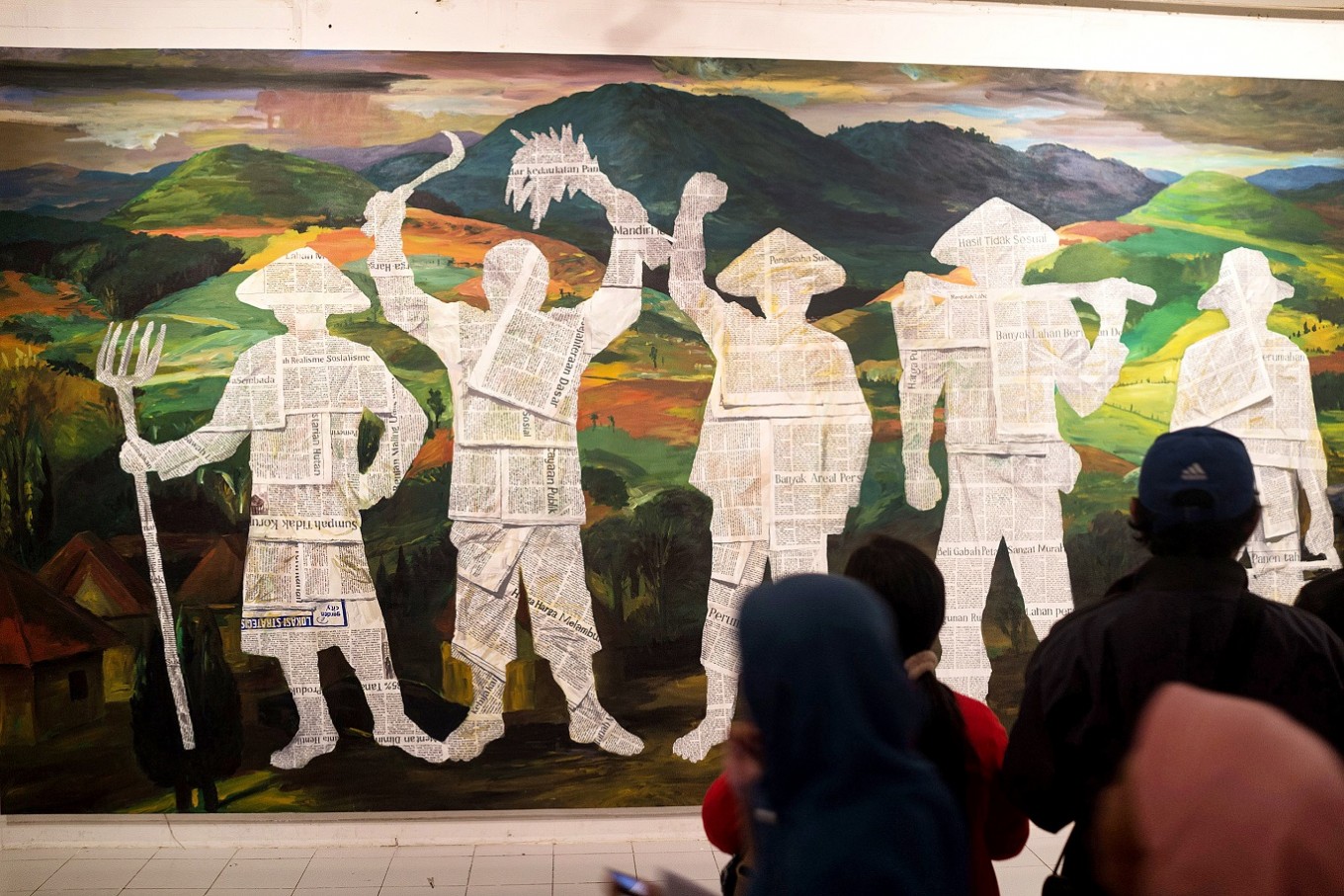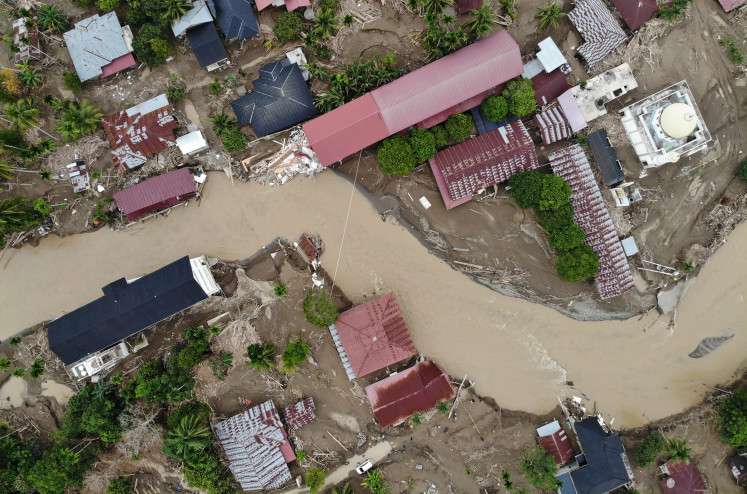Popular Reads
Top Results
Can't find what you're looking for?
View all search resultsPopular Reads
Top Results
Can't find what you're looking for?
View all search resultsUnlocking Indonesian agriculture’s digital future
Public and private bodies could invest in farmer education to demonstrate new technology.
Change text size
Gift Premium Articles
to Anyone
I
magine a farm that “talks” directly to its farmer by mobile phone – sending instant updates about soil nutrients and crop cycles, and urgent alerts to top up water or fertilizer. Futuristic? Fantastical? The technology already exists today, and will be a critical lever for igniting growth in Indonesia’s agriculture sector.
With its wealth of fertile land, Indonesia is a major agricultural player – the fourth largest global producer and an important exporter. Farming is a critical part of Indonesia’s economy, contributing significantly to gross domestic product (GDP) and employing almost a third of the country’s workforce. But these numbers are dropping, with fewer young people interested in entering the field.
This can contribute to a higher reliance on imports and lower incomes for farmers, who are largely smallholders. Farmers’ chief concerns are access to capital, pest and disease management, and market access. The cost of production of staple crops is also 25-50 percent higher in Indonesia than in neighboring countries, according to ACRE, McKinsey’s agricultural advanced-analytics center.
All of these stressors have been exacerbated by COVID-19, which has brought price drops, a scarcity of buyers, and difficulty procuring necessities such as pesticides.
How can farmers boost productivity in this demanding climate? A recent survey by McKinsey & Company – which reached 200 Indonesian farmers in six provinces and 80 villages – unearths some potentially powerful technological solutions.
Agricultural technology (AgTech), including digital innovations, could unlock US$500 billion in additional value to the global GDP by 2030, improve food security and boost productivity. There are many exciting avenues to explore.
Automation, such as using drones or hydrogen balloons to spray pesticides, could vastly impact reliance on manual labor and application time, while smart irrigation devices could slash costs.
Precision farming – the use of big data and advanced analytics to calculate precise inputs and outlays
– can increase yield, while software, online calculators and dashboards can ease management of operations.
For example, Habibi Garden is a start-up that specializes in Internet of Things (IoT) devices. Habibi
Garden’s IoT sensors track key parameters of plant growth such as temperature, humidity, moisture and pH, and send notifications to farmers when action is needed.
Apps can be used to link suppliers, farmers and customers. Indonesian start-up Sayurbox, for example, is a mobile groceries shopping app that lets consumers choose fresh farm produce online, sourced directly from local producers and delivered to doorsteps.
Other digital platforms can assist by providing early-warning weather information, for instance, or by providing digital credit. Personalized on-demand advisory services can be delivered via mobile phones. One example is Pantau Harga, a startup that delivers detailed agricultural-commodity price information to farmers, allowing for more transparent transactions.
Indonesia is well positioned to take advantage of such innovations. A large majority of farmers have reliable access to the internet and use it daily. Around two-thirds use smartphones and are active on social media, often in dedicated farmers’ groups.
While general digital adoption is high, farmers are not yet maximizing the use of technologies for business value. Most farmers still rely on networks of peers, family or friends for agricultural information. Only about a fifth use social media to buy or sell, with even fewer – under 5 percent – active on e-commerce sites.
Our survey indicates that many farmers would be willing to take a chance on digital platforms, and on even less familiar technologies such as drones, but are held back by lack of knowledge and awareness, and a perceived difficulty of use.
Our survey unveiled several central insights into building a digital agricultural economy. These can guide the way forward for both private and public players.
First, understand the farmer first. There is no one-size-fits-all solution – farmers’ requirements will differ based on a range of factors, such type of cropping system, market access, and knowledge of farming practices. For example, rice farmers (mostly smallholders) cite pest management as a key challenge, while for larger-scale sugarcane farmers, worker availability is a more significant obstacle.
Age and background of individual farmers also pays a role. For example, younger farmers (under 40) are twice as likely as older ones to use online channels – but are also more likely to face obstacles to accessing capital.
Second, innovate with tailor-made solutions. Solution design needs to account for farmers’ particular limitations and needs. For example, given that Indonesian farmers earn on average about Rp55,000 a day, affordable, “asset-light” solutions such as drone rentals could be explored.
Solutions need not be wholly digital. E-commerce schemes might explore a range of delivery models that incorporate different combinations of in-person and online purchase and delivery, and the digitization of distribution partners’ operations.
Public and private bodies could invest in farmer education to demonstrate new technology. This might be done via online farmer groups on WhatsApp or Facebook, or via offline cooperatives or trader networks.
Third, avoid pilot paralysis. Delivering successful AgTech solutions is a marathon, not a sprint – long-term investment and commitment are required to deliver a long-lasting, quality product. Investing early in corporate sponsorships, farm-estate partnerships and free-trial programs could help drive adoption at scale. Players must build internal capabilities (especially digital talent and infrastructure) to ensure their model is sustainable beyond the pilot stage.
Fourth, secure the right partnerships. Partnerships can be effective in accelerating and deepening the impact of farmer solutions. For example, partnerships with data platforms could enable better farmer targeting, while partnerships with distributors could enrich local market knowledge and drive adoption.
Fifth, remove barriers to entry. Public-sector players could consider taking a more active role in fostering an AgTech ecosystem – setting up AgTech-specific innovation funds, building an open source data platform and investing in farmer registries, among other strategies.
By marrying digital innovations with Indonesia’s rich agricultural heritage, Indonesia’s farms and farmers can better “talk” to one another and to consumers around the world, in exciting, sustainable, and profitable new ways.
***
Suyin Soon is a partner based in McKinsey & Company’s Singapore office, and Khoon Tee Tan is a senior partner based in Jakarta where Phillia Wibowo is the managing partner.










